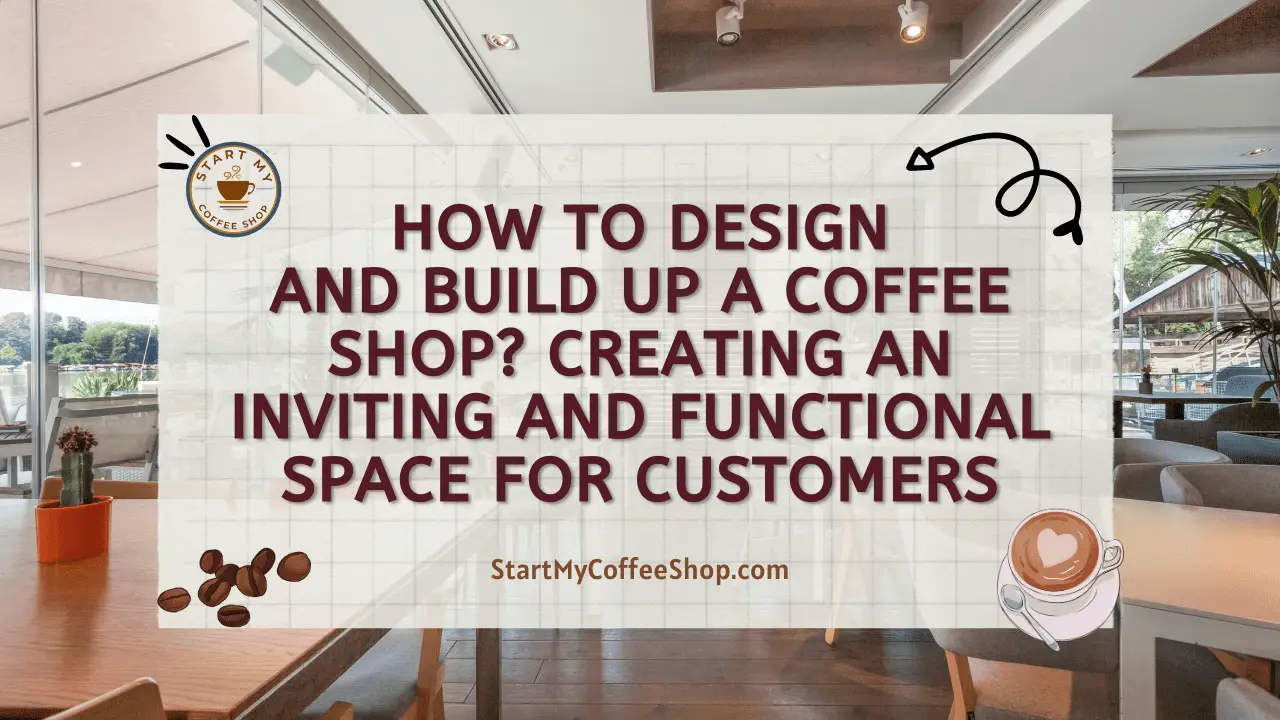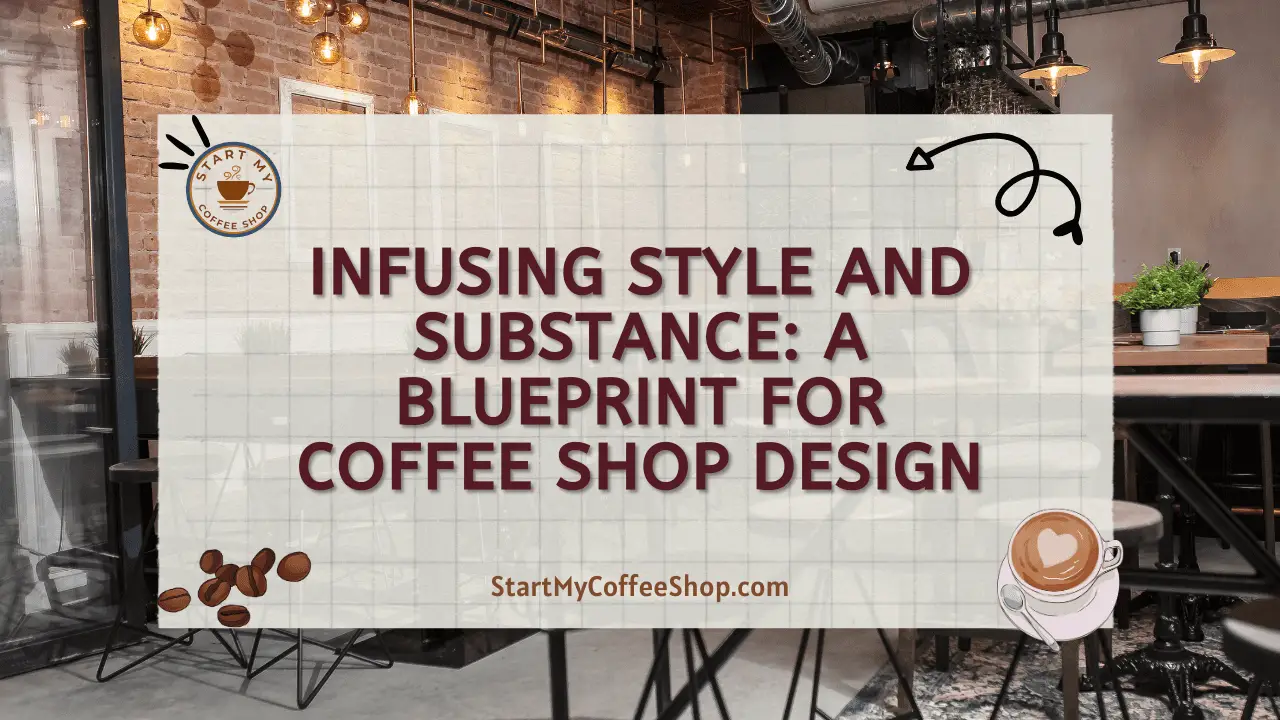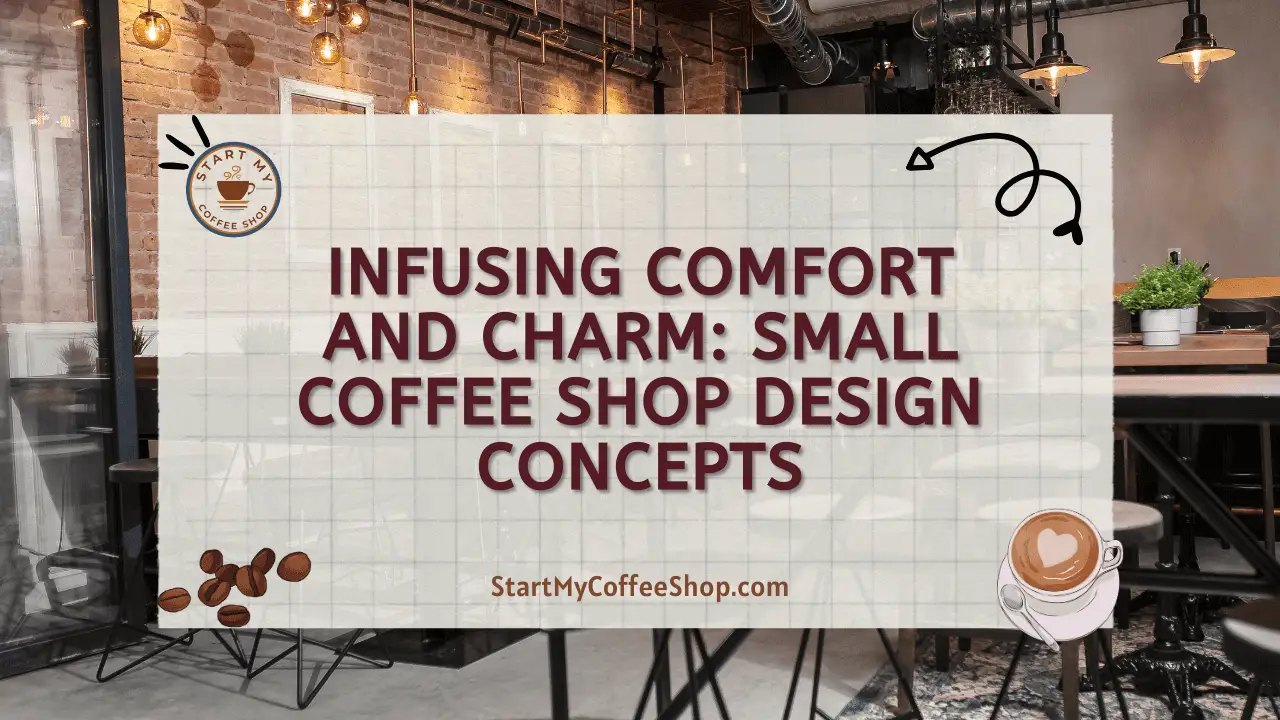The aroma of freshly brewed coffee, the cozy ambiance, and the welcoming atmosphere are all essential elements that make a coffee shop a beloved destination for coffee enthusiasts.
To design and build a coffee shop effectively, consider factors like layout, equipment, interior design, and ambiance. Ensure the layout allows for smooth customer flow, select suitable equipment, create an appealing interior design, and cultivate a welcoming ambiance to provide a functional and inviting space for customers.
In this article, I will explore the key aspects to create a coffee shop that not only attracts customers but also provides them with a delightful experience.
1. Planning the Layout
The layout of a coffee shop is a vital aspect that can greatly influence the overall customer experience and operational efficiency. When designing the layout, it’s essential to consider the available space and strive for an efficient arrangement that enables easy navigation for both customers and staff.
To begin, divide the coffee shop space into distinct areas: the customer seating area, the service counter, the preparation area, and the storage space. Each of these areas serves a specific purpose and contributes to the smooth functioning of the coffee shop.
When it comes to the seating area, comfort and versatility are key. Incorporate a mix of seating options to cater to different customer preferences. Provide comfortable chairs and plush cushions for individuals seeking a cozy corner, as well as larger communal tables for groups or social gatherings. By offering a variety of seating arrangements, you can create a welcoming environment that accommodates diverse customer needs.
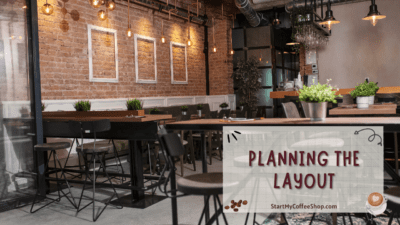
To ensure a seamless flow, carefully consider the movement of customers from the entrance to the service counter. Minimize any potential bottlenecks by organizing the layout in a way that allows for a smooth and unobstructed path. This can involve strategically placing furniture, creating designated walkways, and considering the placement of decorative elements or displays. By optimizing the flow, customers can navigate the space effortlessly, enhancing their overall experience.
Furthermore, pay attention to the positioning of the service counter, which is the focal point of customer-staff interaction. Ensure that it is easily accessible and visible from various angles in the seating area. This enables customers to easily place their orders, while also providing staff with a clear view of the entire space to ensure efficient service.
Lastly, don’t forget to allocate an area for the coffee preparation zone and storage space. This is where baristas can work their magic, crafting delicious beverages for customers. Ensure that the preparation area is equipped with all the necessary tools, such as espresso machines, coffee grinders, and brewing equipment. Additionally, create a well-organized storage space to keep supplies, ingredients, and utensils within easy reach, streamlining the workflow of the staff.
Read more about Cost To Open Coffee Ice Cream Shop: From Investment to Indulgence
2. Selecting Equipment
Equipping your coffee shop with the appropriate tools and machinery is vital for ensuring efficient operations and delivering high-quality beverages. To achieve this, it’s crucial to invest in reliable equipment that suits your specific needs.
Start by considering the essentials: a dependable espresso machine, coffee grinders, and a commercial blender. These are the workhorses of any coffee shop, facilitating the creation of espresso-based beverages, grinding fresh coffee beans, and preparing blended drinks. When selecting these machines, pay attention to their capacity, speed, and durability to ensure they can handle the projected customer volume.
Furthermore, take into account your desired menu offerings when choosing equipment. If your coffee shop aims to specialize in specialty coffee drinks, consider incorporating additional tools such as pour-over stations or alternative brewing methods like Aeropress or Chemex. These methods provide opportunities for manual brewing, highlighting the flavors and nuances of different coffee beans. By diversifying your brewing options, you can cater to customers with varying preferences and offer a unique coffee experience.
Creating an efficient workspace is also crucial. Arrange the equipment logically and ergonomically, allowing baristas to move seamlessly and complete tasks efficiently. Consider the flow of work, ensuring that the machines and tools are easily accessible and organized. A well-organized workspace minimizes the time spent searching for ingredients or equipment, resulting in a more streamlined workflow and faster service.
Finally, prioritize the maintenance and upkeep of your equipment. Regular cleaning, calibration, and servicing are essential for ensuring their longevity and optimal performance. Develop a maintenance schedule and train your staff on proper equipment care to prevent breakdowns and maintain consistent beverage quality.
3. Interior Design
The interior design of a coffee shop plays a pivotal role in shaping its atmosphere and the overall customer experience. To create an inviting and cohesive space, it’s important to start by defining a theme or concept that aligns with your brand and target audience. Whether you envision a cozy rustic vibe or a modern minimalist aesthetic, maintaining consistency in design elements is key.
Begin by selecting furniture that reflects your chosen theme and provides comfort to customers. Opt for seating options that are both aesthetically pleasing and ergonomic, allowing guests to relax and enjoy their coffee. Consider using a mix of styles and sizes to cater to different preferences and group sizes. Additionally, create cozy nooks and open spaces within your coffee shop to accommodate individuals seeking privacy or larger groups wanting to socialize.
Lighting is a crucial aspect of interior design that greatly impacts the ambiance. Take advantage of natural light sources, such as windows or skylights, to infuse the space with warmth and a welcoming feel. Combine natural light with well-placed artificial lighting to create the desired mood. Use warm-toned lighting for a cozy atmosphere, or opt for brighter lights in areas where customers may be reading or working.
Acoustics also play a significant role in creating a pleasant environment. Excessive noise levels can disrupt conversations and detract from the overall experience. Incorporate sound-absorbing materials, such as acoustic panels or soft furnishings, to minimize noise reverberation and create a more peaceful ambiance.
When selecting a color palette, choose tones that evoke the desired emotions and align with your chosen theme. Warm and earthy tones create a cozy and inviting atmosphere, while cooler hues can lend a modern and refreshing feel. Consider using accent colors strategically to add visual interest and highlight key areas of your coffee shop.
Lastly, don’t forget about decor. Thoughtfully chosen artwork, plants, or decorative elements can enhance the overall aesthetic and create a unique atmosphere. Pay attention to the scale and placement of decor items, ensuring they complement the space without overwhelming it.
4. Creating Ambiance
Ambiance is a key factor in setting a coffee shop apart from the rest. It creates a unique and memorable atmosphere that keeps customers coming back for more. When focusing on ambiance, it’s important to consider sensory experiences that engage customers and create a delightful environment.
The aroma of freshly ground coffee is an essential element that immediately captures the attention and creates an inviting atmosphere. Ensure that the aroma permeates the air by using high-quality beans and grinding them on-site. The captivating scent of coffee wafting through the space adds to the overall sensory experience.
Background music can significantly impact the ambiance of a coffee shop. Choose calming and soothing tunes that create a relaxing environment for customers. Soft jazz, acoustic melodies, or instrumental music often work well in enhancing the atmosphere without overpowering conversations or causing distractions.
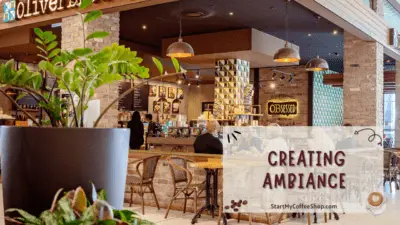
Lighting plays a vital role in setting the mood. Consider using warm and soft lighting to create a cozy and intimate feel. Dimmer switches can provide flexibility to adjust the lighting throughout the day, transitioning from brighter in the morning to softer in the evening. This creates an ambiance that adapts to different customer preferences and occasions.
Incorporating live plants or green walls can bring a touch of nature into the coffee shop, creating a refreshing and vibrant atmosphere. Plants not only add visual appeal but also contribute to improving air quality and creating a sense of tranquility.
Artwork or murals can be used to add character and visual interest to the space. Consider showcasing local artists or featuring coffee-themed artwork that resonates with your brand. Custom-made signage can also enhance the ambiance by adding a personal touch and reinforcing the coffee shop’s unique identity.
Don’t overlook the power of small details in creating an inviting ambiance. Unique coffee mugs, personalized coasters, or even a dedicated reading corner with a selection of books can add charm and comfort to the overall experience. These details help to create a sense of connection and make customers feel valued and appreciated.
Read more about Cost to Startup a Coffee Shop: Unveiling the Startup Costs
5. Ergonomics and Functionality
In a well-designed coffee shop, ergonomics and functionality should be given high priority. The workspace should be optimized for the baristas, providing them with an efficient and practical environment. It is essential to ensure easy access to ingredients, equipment, and storage.
Consider the layout of the counter area where the baristas work. Arrange the tools and equipment in a way that minimizes unnecessary movements, allowing them to quickly and effortlessly prepare beverages. Keep frequently used items within arm’s reach, reducing the time and effort required to retrieve them.
Furthermore, consider the placement of electrical outlets throughout the coffee shop. Providing accessible outlets near seating areas allows customers to conveniently charge their devices without restrictions. This thoughtful consideration enhances the overall customer experience, as people can comfortably enjoy their coffee while staying connected.
Efficiency behind the counter is crucial for delivering prompt service. Establishing a logical workflow and organization system contributes to a faster and smoother operation. Designate specific areas for different tasks, such as order taking, drink preparation, and payment. This division of labor and efficient flow helps minimize waiting times and ensures a seamless customer experience.
Storage is another key aspect to consider. Develop a practical and logical storage system for coffee beans, supplies, and cleaning materials. Keep these items well-organized and easily accessible, enabling baristas to quickly restock and maintain cleanliness. Utilize shelves, cabinets, and designated storage spaces to create an orderly workspace, reducing clutter and increasing efficiency.
6. Collaboration with Professionals
Designing and constructing a coffee shop from scratch can be a complex undertaking. Consider collaborating with professionals such as architects, interior designers, and contractors who specialize in commercial spaces. Their expertise and experience will ensure that your vision for the coffee shop is translated into a functional and visually appealing space.
Architects can assist in optimizing the layout, ensuring proper ventilation, and complying with building codes and regulations. Interior designers can help create a cohesive design concept, select appropriate materials and finishes, and provide guidance on furniture placement and lighting. Contractors will handle the construction process, including plumbing, electrical work, and carpentry, ensuring that everything is built to code.
Working with professionals not only ensures a smoother construction process but also adds value to your coffee shop by leveraging their expertise in creating functional and aesthetically pleasing spaces.
Summary
Designing and constructing a coffee shop from scratch involves careful consideration of various factors. From planning the layout to selecting equipment, from interior design to creating the right ambiance, each element contributes to creating an inviting and functional space for customers.
Remember to prioritize efficiency, comfort, and aesthetics when designing the layout. Choose high-quality equipment that aligns with your menu offerings and projected customer volume. Pay attention to interior design, creating a cohesive and inviting atmosphere. Finally, collaborate with professionals who can bring your vision to life.
By incorporating these considerations into your coffee shop design and construction, you can create a space that not only attracts customers but also provides them with a memorable and enjoyable experience. So go ahead, take that leap, and build the coffee shop of your dreams!
Frequently Asked Questions

Q: How much space do I need to design and construct a coffee shop?
A: As a general guideline, aim for a minimum of 500-800 square feet for a small coffee shop with limited seating. However, larger spaces are recommended for accommodating more customers and providing comfortable seating options.
Q: How can I ensure an efficient workflow in my coffee shop?
A: To achieve an efficient workflow, consider the layout and organization of your coffee shop. Designate distinct areas for customer seating, service counter, preparation, and storage. Minimize obstructions and optimize the flow of customers and staff.
Q: What factors should I consider when selecting equipment for my coffee shop?
A: When choosing equipment, consider factors such as capacity, speed, durability, and compatibility with your menu offerings.
To learn more on how to start your own coffee shop checkout my startup documents here
Please note: This blog post is for educational purposes only and does not constitute legal advice. Please consult a legal expert to address your specific needs.

Hi! I’m Shawn Chun
My adventure in coffee began when I first launched my first coffee shop back in the early 2000s. I had to figure out so many things on my own and to make it worse within 2 years of opening two large corporate coffee chains moved in just blocks away from me!
As I saw smaller and even some larger coffee shops in the neighborhood slowly lose customers to these giant coffee chains and slowly close up shop, I knew that I had to start getting creative…or go out of business.
I (like you may be) knew the coffee industry well. I could make the best latte art around and the foam on my caps was the fluffiest you have ever seen. I even had the best state-of-the-art 2 group digital Nuova Simonelli machine money could buy. But I knew that these things alone would not be enough to lure customers away from the name brand established coffee shops.
Eventually, through lots of trial and error as well as perseverance and creativity I did find a way to not only survive but also thrive in the coffee/espresso industry even while those corporate coffee chains stayed put. During those years I learned to adapt and always faced new challenges. It was not always easy, however, in the end, I was the sole survivor independent coffee shop within a 10-mile radius of my location. Just two corporate coffee chains and I were left after that year. All told the corporate coffee chains took down over 15 small independent coffee shops and kiosks and I was the last one standing and thriving.
Along the years I meet others with the same passion for coffee and I quickly learned that it is not only “how good a barista is” that makes a coffee shop successful, but the business side of coffee as well.
Hence why I started this website you are on now. To provide the tools and resources for up and coming coffee shop owners to gain that vital insight and knowledge on how to start a coffee shop successfully.
Stick around, browse through my helpful blog and resources and enjoy your stay! With lots of LATTE LOVE!
Shawn

